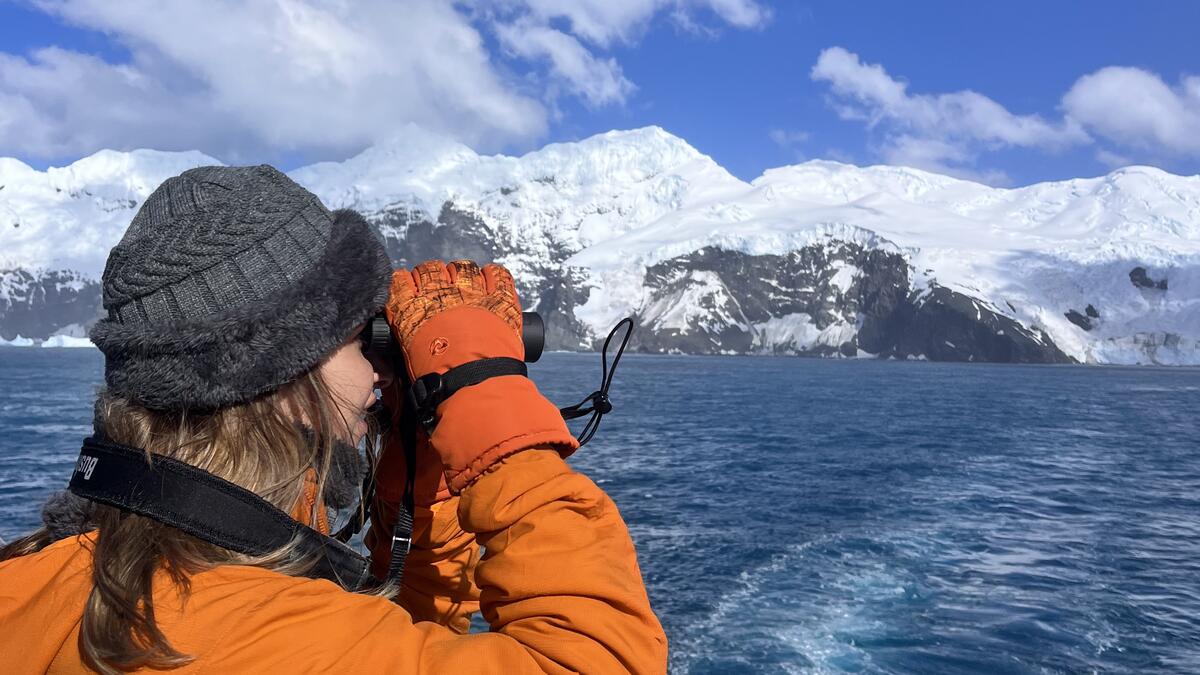Viral finds on the frozen frontier: 13 new papillomaviruses discovered in Antarctic seals

Melanie Regney during her trip to Antarctica. Courtesy photo
Antarctica is the least explored place in the world, but Arizona State University researchers are changing that: Recently, they discovered 13 novel papillomaviruses carried by Antarctic seals.
That discovery, which was recently published in the journal Virology, will help future researchers understand the evolution of papillomaviruses, a large viral family that infects all sorts of species, from humans and reptiles to birds and mammals (including seals).
Though researchers have been studying papillomaviruses for decades, they’ve largely looked for those viruses in humans. Melanie Regney, a second-year PhD student in the Varsani Lab and the lead author of the paper, is excited about searching for viruses in creatures that other scientists have overlooked to add to the knowledge we have about viruses overall.
“Viruses are everywhere,” she explains. “They’re the most abundant entity in the universe. But despite that, they’re one of the things we know the least about. We don’t even know most of them exist.”
All the researchers at the Varsani Lab have a similar goal of filling in the huge gap of knowledge about what viruses exist in our world. However, the researchers look for viruses in very different places: in New Zealand parrots, ASU’s honeybee colonies, Canadian lynx and even the ducks in Tempe’s Kiwanis Park. Regney focuses on species in the Antarctic, mainly penguins and seals, because she’s interested in Antarctica itself.
“Antarctica as a whole continent is very pristine. It’s the only one that still remains the least touched by human presence ... so we don’t know a lot about it. Studying the evolutionary aspect of Antarctica’s virome there is very important to understand how the ecosystem works there.”
For this study, Regney and her team worked with tissue samples from three species of Antarctic seals: Weddell seals, leopard seals and Antarctic fur seals, out of which only Weddell seals had been previously studied. Regney’s team sequenced those viruses’ genomes and compared them with the genomes of known papillomaviruses, revealing that they had found 13 novel papillomaviruses, 11 of which are entirely new viral types.
After sequencing the novel viruses, Regney and her collaborators used a phylogenetic, or evolutionary tree, to reveal the evolution of papillomaviruses and how closely they are related. They found that the viruses in Antarctic seals are most closely related to papillomaviruses that infect other carnivores, reflecting that the papillomaviruses are very species-specific and likely co-evolved with each species.
Additionally, the team found that nine of the viruses they identified had a gene that could potentially be cancer causing, such as two types of papillomaviruses that infect humans: HPV 16 and 18. Though Regney’s team does not know whether these viruses are causing cancer in Antarctic seals, they suggest that further research should be done to find out in order to protect the iconic creatures.
This is Regney’s first publication in an academic journal, but she hopes it's far from her last. She plans to conduct more research identifying and classifying Antarctic viruses throughout her PhD and hopes to be able to travel to Antarctica to sample some of the species she studies herself.
This past January, she traveled to Antarctica for the first time, where she at last got up close with the environment she’s been studying from afar.
“It was the best experience of my life. You feel so small. Everything else is so big, and everything is so meaningful, and you get to be part of it. If there is any opportunity, I want to go back,” she said.
However, it also left Regney concerned: “Antarctica is impacted by our actions on the other side of the world. Glaciers are melting, ice caps are separating and the changes in temperature are affecting all the species there.”
Regney hopes her work will help humans better understand the lives of Antarctic species and enable people to better protect them.
More Science and technology

Transforming Arizona’s highways for a smoother drive
Imagine you’re driving down a smooth stretch of road. Your tires have firm traction. There are no potholes you need to swerve to avoid. Your suspension feels responsive. You’re relaxed and focused on…

The Sun Devil who revolutionized kitty litter
If you have a cat, there’s a good chance you’re benefiting from the work of an Arizona State University alumna. In honor of Women's History Month, we're sharing her story.A pioneering chemist…

ASU to host 2 new 51 Pegasi b Fellows, cementing leadership in exoplanet research
Arizona State University continues its rapid rise in planetary astronomy, welcoming two new 51 Pegasi b Fellows to its exoplanet research team in fall 2025. The Heising-Simons Foundation awarded the…


